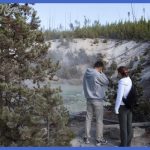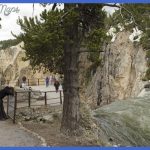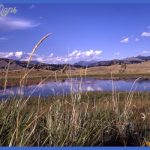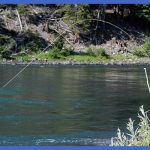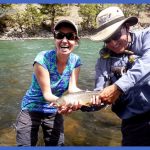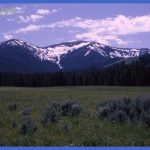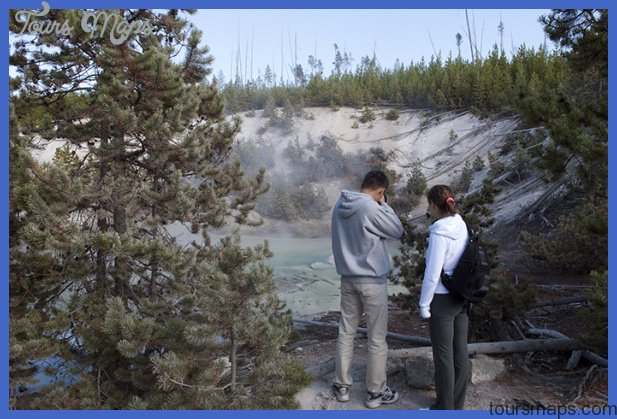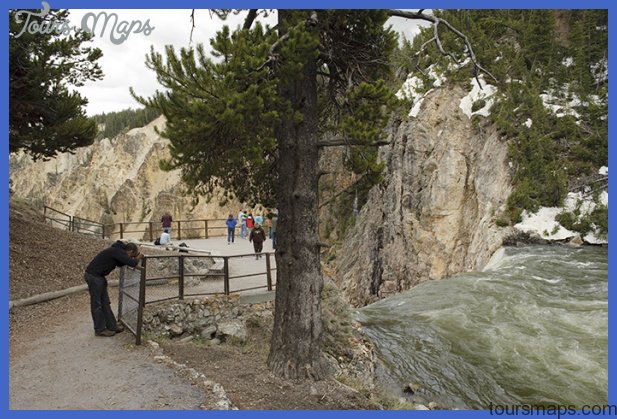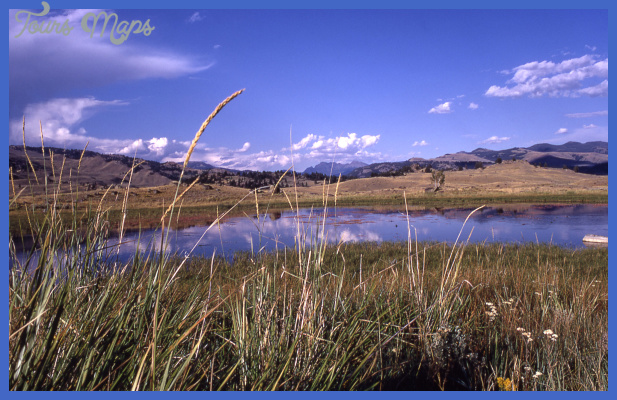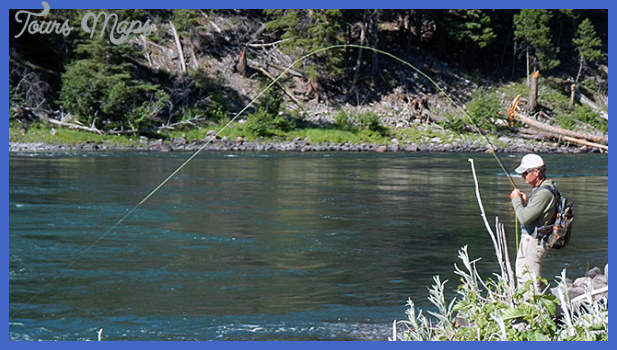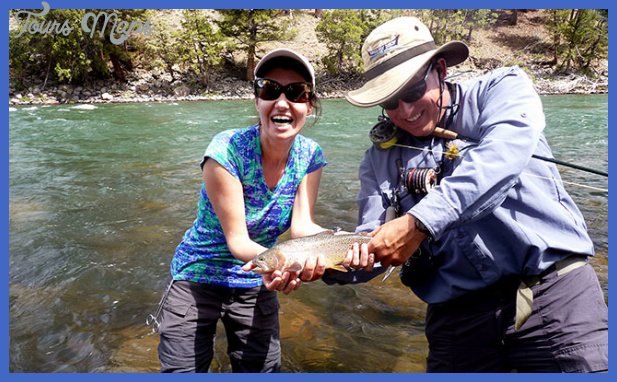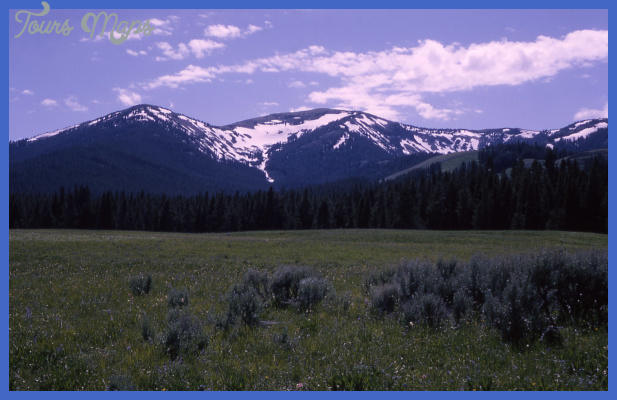The northern valleys average a little lower and drier than the central plateaus overall, and the high desert ecology along the 5 miles of road between Gardiner and Mammoth is unique in the park, for precipitation there is sometimes as low as 11 inches (28 cm) in a year. In contrast, the Lamar River valley is a little higher and has about 30 inches (76 cm) of precipitation a year. The ecology of these river valleys is also heavily influenced by glacial scouring, which has brought down volcanic and sedimentary soils from surrounding mountains. The soil holds water well and is high in plant nutrients. These are places where bison and elk thrive. Valley Trees Douglas fir (Pseudotsuga menziesii) is the evergreen you’ll often see growing singly in the lee of big boulders along the road between Mammoth Hot Springs and the Northeast Entrance (it’s pictured on 209). Its scientific name means false hemlock, and it is not really a fir (genus Abies) at all. The needles grow around the branch, and the hanging female cones have little tridents between their scales. An old Douglas fir will have very thick, deeply fissured bark that protects it from fires. The limber pine (Pinus flexilis) has young branches so flexible they can be tied in knots without breaking. This pine grows at high altitudes, and its needles grow in bundles of five. Its cones are up to 8 inches (20 cm) long and green.
The limber pine is common and very long-lived near Mammoth Hot Springs. In the park, the shrub Rocky Mountain juniper (Juniperus scopulorum) grows only around Mammoth (it’s pictured on 272). Its scaly leaves look much like a cedar’s, and its seed cones look like blue berries. Some junipers are lollipop-shaped, with bare trunks and bushy tops, a result of elk browsing on them in winter. There is an example of this tree that is more than 1500 years old growing at Mammoth Hot Springs. One of the three deciduous trees at home in northern Yellowstone is the quaking aspen (Populus tremuloides), which grows in sunny places on hillsides where there’s abundant ground water. Aspens are distinguished by white trunks and by leaves that quake or shiver in the slightest breeze due to flattened leafstalks. Fire does not destroy a stand of aspen, because the trees reproduce mainly by cloning from rhizomes, specialized horizontal root systems full of nutrients. One unexpected positive result of the 1988 fires was aspen’s spreading into burned-over meadows, where thick vegetation had previously crowded out any aspen seedlings. Both ofthe area’s other deciduous trees are types of cottonwood, the narrowleaf cottonwood (Populus angustifolia) and the black cottonwood or balsam poplar (Populus balsamifera). Look for cottonwoods along the Lamar River and at the confluence of the Lamar and Yellowstone rivers. Black cottonwood have thick, furrowed, gray bark and trunks up to 3 feet (1 m) in diameter; the narrowleaf cottonwood is much smaller. Valley shrubs and flowers Many plants grow only in the park’s relatively lower elevations.
For example, along all the rivers and some creeks are many species of willow (Salix spp.), which provide nutritious forage for elk, as do the stems, leaves, and bark of the aspen. Yet low Big sagebrush (Artemisia tridentata) is so common in most of the west as to be a symbol of the dry western plains. It’s a gray-green shrub from 2 to 10 feet (60 cm-3 m) tall, bearing three-toothed leaves on many branches (see its picture on 244). A similar low bush found in the northern part of the park is common rabbitbrush (Chrysothamnus nauseosus). It’s a rather nondescript plant with almost needlelike leaves covered with woolly white hairs, but in late August and September it bursts out with yellow flowers. Two yellow flowers that resemble the snapdragons are the butter-and-eggs (Linaria vulgaris) and Dalmatian toadflax (Linaria dalmatica). These are exotics (that is, non-native plants), introduced to Mammoth from Europe. Park managers are trying to control the spread of these and other exotics whenever possible. Only in the high desert area between Gardiner and Mammoth will you see a cactus.
It’s the plains prickly pear (Opuntia polycantha), and its fleshy stems are covered with spines that are unpleasant to brush against. The rose-like flowers are usually yellow but may be pink or purple on the outside if not fully opened. Pronghorn and elk will eat prickly pear in a hard winter. Prickly pear Blue/Purple Larkspur (Delphinium nelsoni and other species) often grows where sagebrush is abundant. It’s easy to recognize for the tubular spur that protrudes sideways from its deep purple blossom on a 1 to 2 foot (30-60 cm) stem. Larkspur is poisonous to cattle but not to sheep; elk avoid it until late summer.
THE VALLEYS OF THE LOWER YELLOWSTONE, LAMAR, AND GARDNER RIVERS Photo Gallery
Maybe You Like Them Too
- The Best Cities To Visit in The World
- World’s 10 Best Places To Visit
- Coolest Countries in the World to Visit
- Travel to Santorini, Greece
- Map of Barbados – Holiday in Barbados

